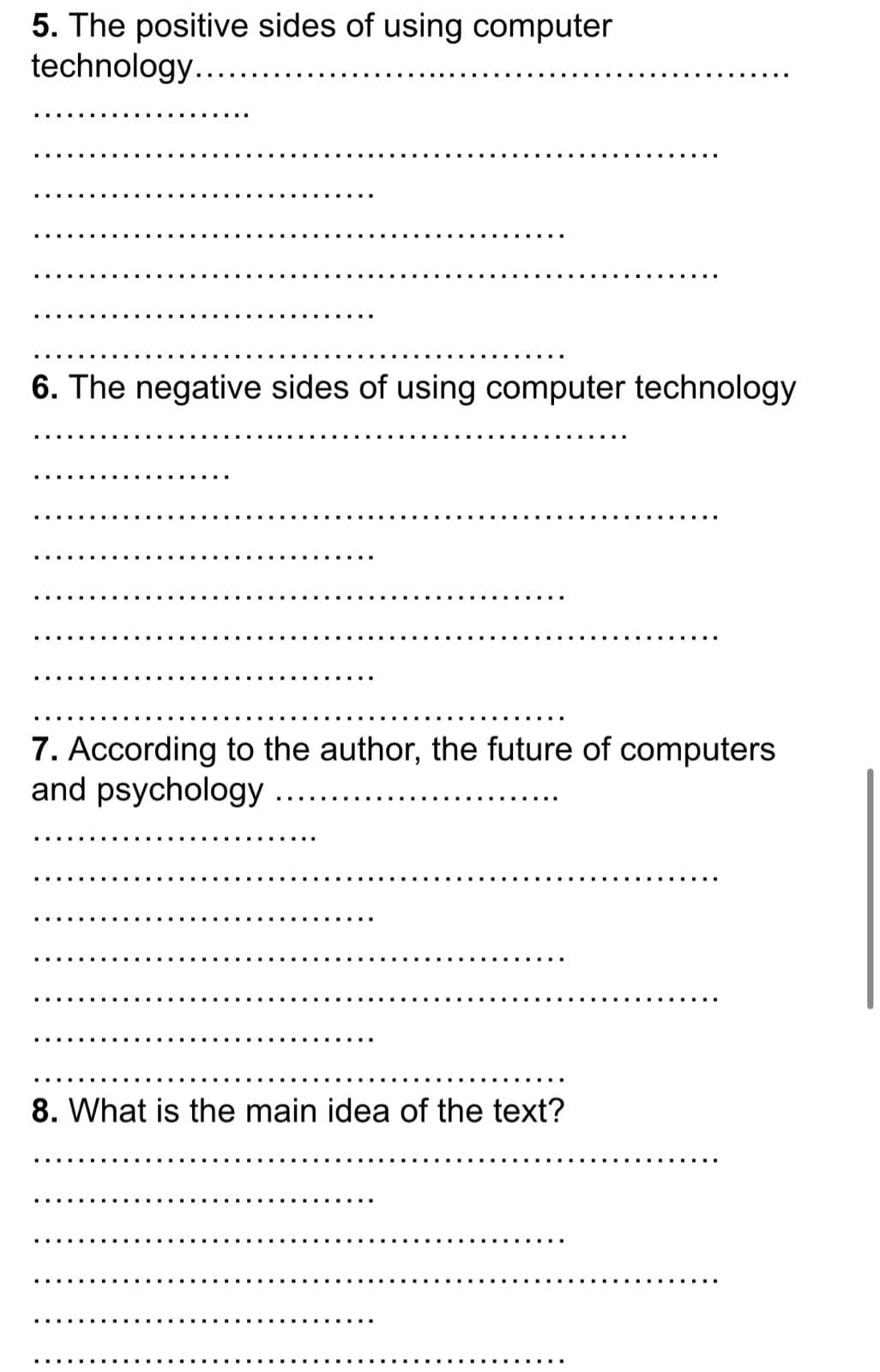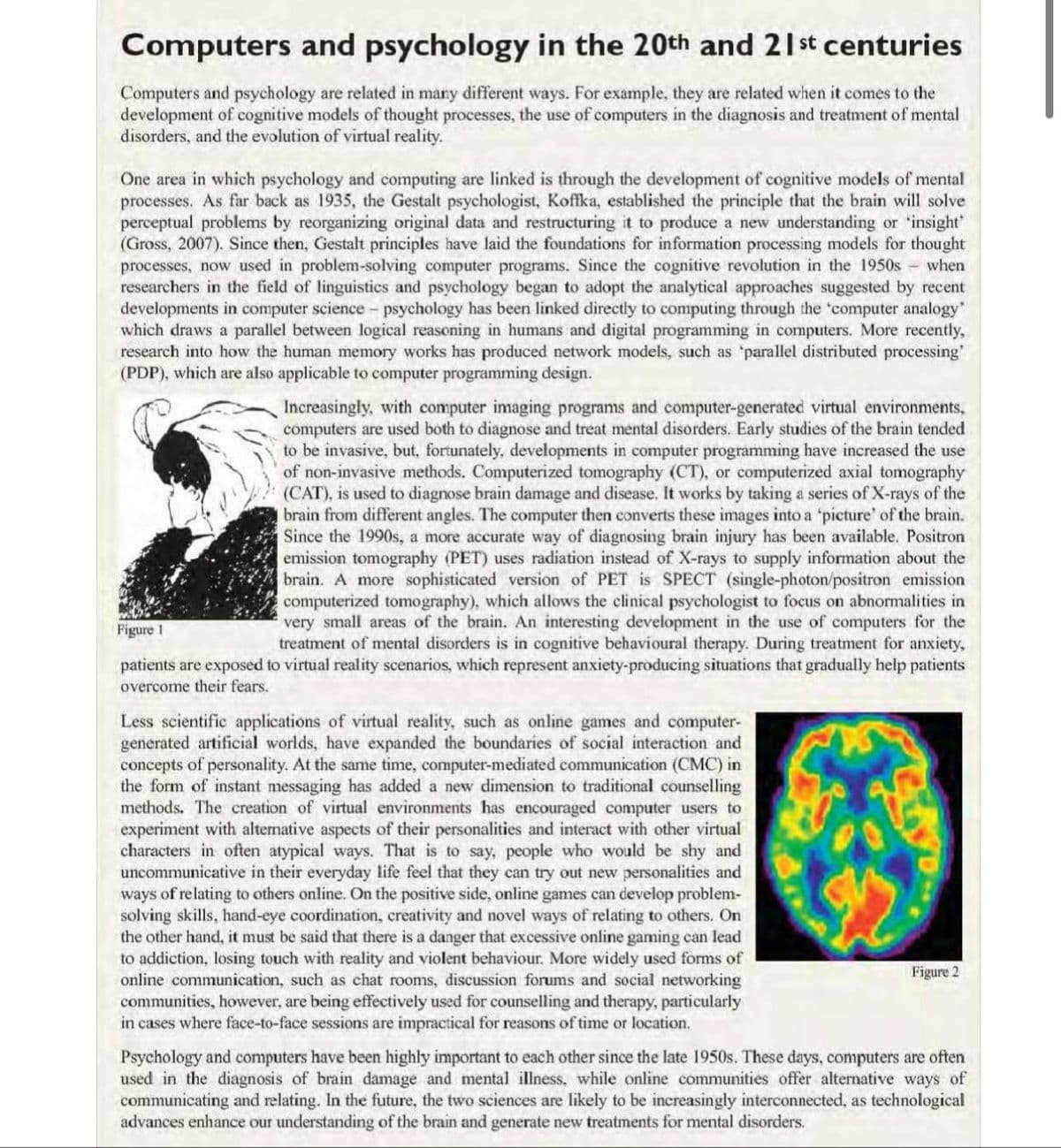5. The positive sides of using computer technology... .... 6. The negative sides of using computer technology 7. According to the author, the future of computers and psychology
5. The positive sides of using computer technology... .... 6. The negative sides of using computer technology 7. According to the author, the future of computers and psychology
Ciccarelli: Psychology_5 (5th Edition)
5th Edition
ISBN:9780134477961
Author:Saundra K. Ciccarelli, J. Noland White
Publisher:Saundra K. Ciccarelli, J. Noland White
Chapter1: The Science Of Psychology
Section: Chapter Questions
Problem 1TY
Related questions
Question

Transcribed Image Text:5. The positive sides of using computer
technology...
6. The negative sides of using computer technology
.....
7. According to the author, the future of computers
and psychology
8. What is the main idea of the text?

Transcribed Image Text:Computers and psychology in the 20th and 21st centuries
Computers and psychology are related in many different ways. For example, they are related when it comes to the
development of cognitive models of thought processes, the use of computers in the diagnosis and treatment of mental
disorders, and the evolution of virtual reality.
One area in which psychology and computing are linked is through the development of cognitive models of mental
processes. As far back as 1935, the Gestalt psychologist, Kofka, established the principle that the brain will solve
perceptual problems by reorganizing original data and restructuring it to produce a new understanding or insight'
(Gross, 2007). Since then, Gestalt principles have laid the foundations for information processing models for thought
processes, now used in problem-solving computer programs. Since the cognitive revolution in the 1950s - when
researchers in the field of linguistics and psychology began to adopt the analytical approaches suggested by recent
developments in computer science- psychology has been linked directly to computing through the 'computer analogy"
which draws a parallel between logical reasoning in humans and digital programming in computers. More recently,
research into how the human memory works has produced network models, such as 'parallel distributed processing'
(PDP), which are also applicable to computer programming design.
Increasingly, with computer imaging programs and computer-generated virtual environments,
computers are used both to diagnose and treat mental disorders. Early studies of the brain tended
to be invasive, but, fortunately, developments in computer programming have increased the use
of non-invasive methods. Computerized tomography (CT), or computerized axial tomography
(CAT), is used to diagnose brain damage and disease. It works by taking a series of X-rays of the
brain from different angles. The computer then converts these images into a 'picture' of the brain.
Since the 1990s, a more accurate way of diagnosing brain injury has been available. Positron
emission tomography (PET) uses radiation instead of X-rays to supply information about the
brain. A more sophisticated version of PET is SPECT (single-photon/positron emission
computerized tomography), which allows the clinical psychologist to focus on abnormalities in
very small areas of the brain. An interesting development in the use of computers for the
treatment of mental disorders is in cognitive behavioural therapy. During treatment for anxiety,
patients are exposed to virtual reality scenarios, which represent anxiety-producing situations that gradually help patients
Figure 1
overcome their fears.
Less scientific applications of virtual reality, such as online games and computer-
generated artificial worlds, have expanded the boundaries of social interaction and
concepts of personality. At the same time, computer-mediated communication (CMC) in
the form of instant messaging has added a new dimension to traditional counselling
methods. The creation of virtual environments has encouraged computer users to
experiment with alternative aspects of their personalities and interact with other virtual
characters in often atypical ways. That is to say, people who would be shy and
uncommunicative in their everyday life feel that they can try out new personalities and
ways of relating to others online. On the positive side, online games can develop problem-
solving skills, hand-eye coordination, creativity and novel ways of relating to others. On
the other hand, it must be said that there is a danger that excessive online gaming can lead
to addiction, losing touch with reality and violent behaviour. More widely used forms of
online communication, such as chat rooms, discussion forums and social networking
communities, however, are being effectively used for counselling and therapy, particularly
in cases where face-to-face sessions are impractical for reasons of time or location.
Figure 2
Psychology and computers have been highly important to each other since the late 1950s. These days, computers are often
used in the diagnosis of brain damage and mental illness, while online communities offer alternative ways of
communicating and relating. In the future, the two sciences are likely to be increasingly interconnected, as technological
advances enhance our understanding of the brain and generate new treatments for mental disorders.
Expert Solution
This question has been solved!
Explore an expertly crafted, step-by-step solution for a thorough understanding of key concepts.
Step by step
Solved in 3 steps

Recommended textbooks for you

Ciccarelli: Psychology_5 (5th Edition)
Psychology
ISBN:
9780134477961
Author:
Saundra K. Ciccarelli, J. Noland White
Publisher:
PEARSON

Cognitive Psychology
Psychology
ISBN:
9781337408271
Author:
Goldstein, E. Bruce.
Publisher:
Cengage Learning,

Introduction to Psychology: Gateways to Mind and …
Psychology
ISBN:
9781337565691
Author:
Dennis Coon, John O. Mitterer, Tanya S. Martini
Publisher:
Cengage Learning

Ciccarelli: Psychology_5 (5th Edition)
Psychology
ISBN:
9780134477961
Author:
Saundra K. Ciccarelli, J. Noland White
Publisher:
PEARSON

Cognitive Psychology
Psychology
ISBN:
9781337408271
Author:
Goldstein, E. Bruce.
Publisher:
Cengage Learning,

Introduction to Psychology: Gateways to Mind and …
Psychology
ISBN:
9781337565691
Author:
Dennis Coon, John O. Mitterer, Tanya S. Martini
Publisher:
Cengage Learning

Psychology in Your Life (Second Edition)
Psychology
ISBN:
9780393265156
Author:
Sarah Grison, Michael Gazzaniga
Publisher:
W. W. Norton & Company

Cognitive Psychology: Connecting Mind, Research a…
Psychology
ISBN:
9781285763880
Author:
E. Bruce Goldstein
Publisher:
Cengage Learning

Theories of Personality (MindTap Course List)
Psychology
ISBN:
9781305652958
Author:
Duane P. Schultz, Sydney Ellen Schultz
Publisher:
Cengage Learning